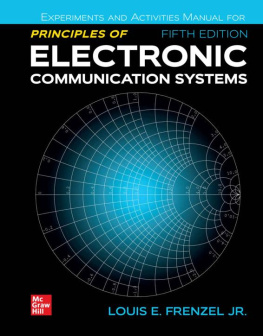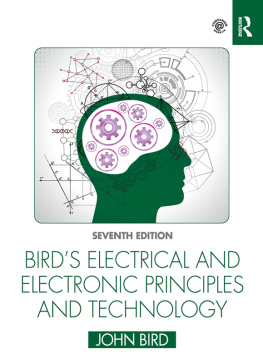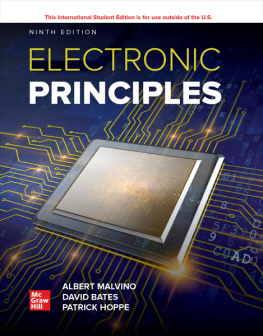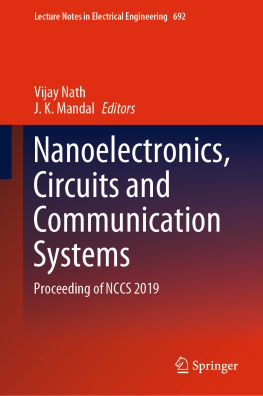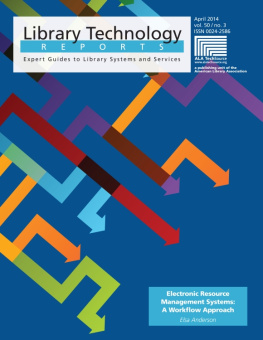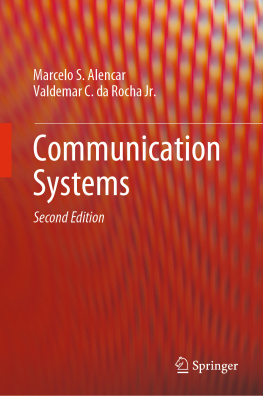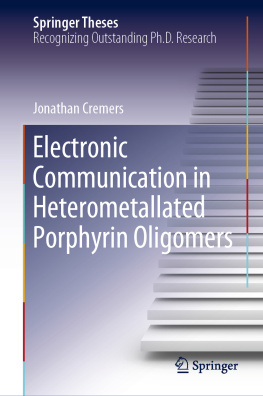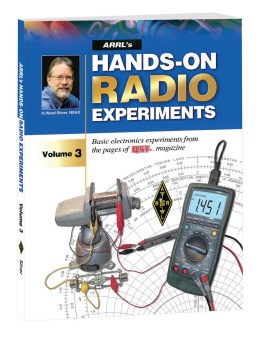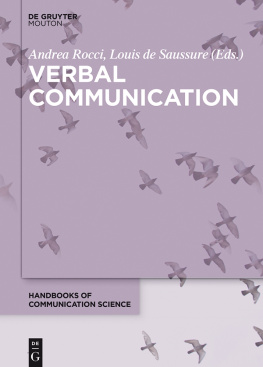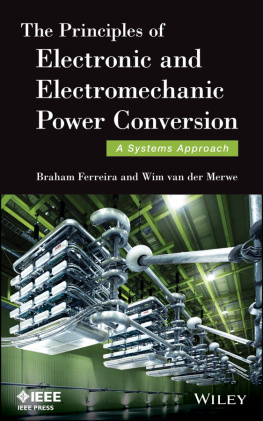Louis Frenzel - Experiments Manual for Principles of Electronic Communication Systems
Here you can read online Louis Frenzel - Experiments Manual for Principles of Electronic Communication Systems full text of the book (entire story) in english for free. Download pdf and epub, get meaning, cover and reviews about this ebook. year: 2022, publisher: McGraw-Hill Higher Education, genre: Home and family. Description of the work, (preface) as well as reviews are available. Best literature library LitArk.com created for fans of good reading and offers a wide selection of genres:
Romance novel
Science fiction
Adventure
Detective
Science
History
Home and family
Prose
Art
Politics
Computer
Non-fiction
Religion
Business
Children
Humor
Choose a favorite category and find really read worthwhile books. Enjoy immersion in the world of imagination, feel the emotions of the characters or learn something new for yourself, make an fascinating discovery.
- Book:Experiments Manual for Principles of Electronic Communication Systems
- Author:
- Publisher:McGraw-Hill Higher Education
- Genre:
- Year:2022
- Rating:4 / 5
- Favourites:Add to favourites
- Your mark:
- 80
- 1
- 2
- 3
- 4
- 5
Experiments Manual for Principles of Electronic Communication Systems: summary, description and annotation
We offer to read an annotation, description, summary or preface (depends on what the author of the book "Experiments Manual for Principles of Electronic Communication Systems" wrote himself). If you haven't found the necessary information about the book — write in the comments, we will try to find it.
Experiments Manual for Principles of Electronic Communication Systems — read online for free the complete book (whole text) full work
Below is the text of the book, divided by pages. System saving the place of the last page read, allows you to conveniently read the book "Experiments Manual for Principles of Electronic Communication Systems" online for free, without having to search again every time where you left off. Put a bookmark, and you can go to the page where you finished reading at any time.
Font size:
Interval:
Bookmark:
page i
Experiments and Activities
Manual for
Principles of
Electronic
Communication
Systems
Fifth Edition
Louis E. Frenzel Jr.

page ii

EXPERIMENTS AND ACTIVITIES MANUAL FOR PRINCIPLES OF ELECTRONIC COMMUNICATION SYSTEMS, FIFTH EDITION
Published by McGraw Hill LLC, 1325 Avenue of the Americas, New York, NY 10019. Copyright 2023 by McGraw Hill LLC. All rights reserved. Printed in the United States of America. Previous editions 2016, 2008, and 2001. No part of this publication may be reproduced or distributed in any form or by any means, or stored in a database or retrieval system, without the prior written consent of McGraw Hill LLC, including, but not limited to, in any network or other electronic storage or transmission, or broadcast for distance learning.
Some ancillaries, including electronic and print components, may not be available to customers outside the United States.
This book is printed on acid-free paper.
1 2 3 4 5 6 7 8 9 LKD 27 26 25 24 23 22
ISBN 978-1-260-78937-9
MHID 1-260-78937-3
Cover image: Audrius Marfeldas/Shutterstock
All credits appearing on page or at the end of the book are considered to be an extension of the copyright page.
The Internet addresses listed in the text were accurate at the time of publication. The inclusion of a website does not indicate an endorsement by the authors or McGraw Hill LLC, and McGraw Hill LLC does not guarantee the accuracy of the information presented at these sites.
mheducation.com/highered
page iii

page iv

page v

This manual is to accompany the textbook Principles of Electronic Communications Systems (PECS), fifth edition. That text was written to support a one- or two-semester course in the fundamentals of communications systems including wireless and networking, both analog and digital. The text is written at the technology level and provides coverage for both 2-year community college and technical school programs through 4-year bachelor of technology programs. This manual serves as a supplement to the text and provides practical student activities as well as laboratory experiments, given the appropriate equipment.
There are always limits as to the extent of coverage of any textbook. Given practical page limits in addition to the time constraints of any college course, a text can cover only so much. The scope and breadth of coverage has been balanced with depth of coverage. However, this manual serves the instructor and the student in providing not only validation of principles in the text but also the opportunity to dig deeper on a variety of subjects with both Internet access and hands-on lab experiments.
Organization of this Manual
This manual is divided into two types of projects, activities and lab experiments. The projects are targeted at specific chapters and are numbered as such. For example, Project 3-2 is the second project related to Chapter 3.
Activities
The activities are primarily Internet searches or Web page accesses to acquire additional information on specific topics. Some activities provide questions to answer from the material found. With Web access and search being the dominant method of information gathering on the job in the real-world today, the activities provide students the chance to practice the process they will use considerably in their future employment. Most projects have specific questions to answer by referencing the accessed materials.
The projects typically give relevant websites to avoid excessive search time. Use these websites first to answer the questions. Then use a search via Google, Yahoo, or Bing, using specific search terms to find other answers not in the referenced material.
Lab Experiments
Lab experiments are projects using actual electronic and/or computer hardware to demonstrate and validate key theoretical concepts. The goal is to provide a minimum of true hands-on practice with real test equipment, components, and related hardware.
How to Use this Manual
The projects assume that you have read the related chapter and/or have had one or more lectures on the subject. Instructors will assign relevant projects best fitting their goals for the course. Otherwise, students should feel free to select projects of interest and pursue them.
Lab Equipment
Most colleges have adequate lab equipment for teaching basic electronics as well as digital circuits and microcomputers. However, few have suitable lab equipment for teaching communications hardware. It is typically more expensive than basic instruments and trainers and can certainly be more difficult to use. Working with RF circuits and equipment is particularly challenging.
For these reasons, the lab experiments in the manual have been simplified as much as possible without compromising the teaching of the fundamentals. Furthermore, low cost was a key consideration in choosing the lab experiments. One way to do this is to use circuits that operate at much lower frequencies. Instead of VHF, UHF, and microwave signals that are the most common today, this manual uses low RF and in many cases audio and midrange frequencies below 1 MHz. This makes the circuits less expensive, less critical, and more adaptable to traditional breadboards. An effort has been made to use the older DIP ICs rather than the more common surface-mount devices so common in wireless and communications gear today. Finally, by using the lower frequencies, commonly available test equipment is typically acceptable.
Breadboards and Trainers
Standard breadboards and trainers may be used for most of the experiments described in the manual. The key to making the circuits work is to keep the component leads and interconnecting wires short and the components grouped closer together to minimize the stray inductance, capacitance, and coupling. All power supplies should be bypassed with 0.1-F ceramic capacitors where they attach to the breadboard to minimize noise, coupling, and other problems.
page vi
A good choice for a general-purpose trainer is the National Instruments (NI) ELVIS. See Figure 1. It contains the usual breadboarding sockets as well as multiple power supplies and a function generator. And it is designed to connect to a PC or laptop running NI LabVIEW software that converts the computer into a group of virtual instruments (VIs), which include a multimeter and oscilloscope. This combination is hard to beat since the complete lab station, breadboard, trainer, power supplies, generators, and instruments are contained in two units, the ELVIS trainer itself and the PC. All of the experiments have been tested on the ELVIS trainer. I highly recommend it, as the availability of the LabVIEW software provides useful virtual instruments and allows the demonstration of DSP and other concepts that are impossible with common hardware.
Virtual Instrumentation Trainers
Some colleges are now using virtual test instruments instead of the traditional bench test instruments. A virtual instrument is one that is implemented on a computer. Special circuitry and software is used to create a DMM, oscilloscope, function generator, spectrum analyzer, and even power supplies by using a desktop or laptop computer. The computer screen serves as the readout for the meter, scope, and any other instruments available. On-screen knobs, switches and other controls are manipulated with the mouse.
Next pageFont size:
Interval:
Bookmark:
Similar books «Experiments Manual for Principles of Electronic Communication Systems»
Look at similar books to Experiments Manual for Principles of Electronic Communication Systems. We have selected literature similar in name and meaning in the hope of providing readers with more options to find new, interesting, not yet read works.
Discussion, reviews of the book Experiments Manual for Principles of Electronic Communication Systems and just readers' own opinions. Leave your comments, write what you think about the work, its meaning or the main characters. Specify what exactly you liked and what you didn't like, and why you think so.

